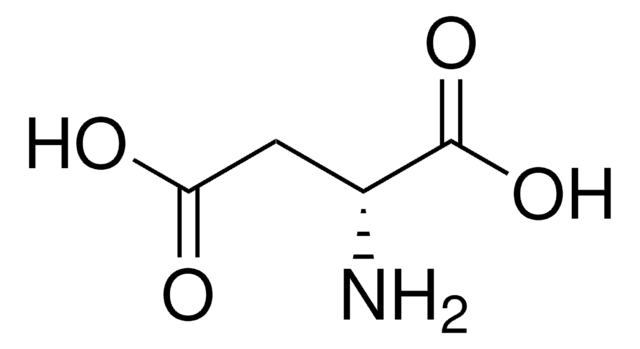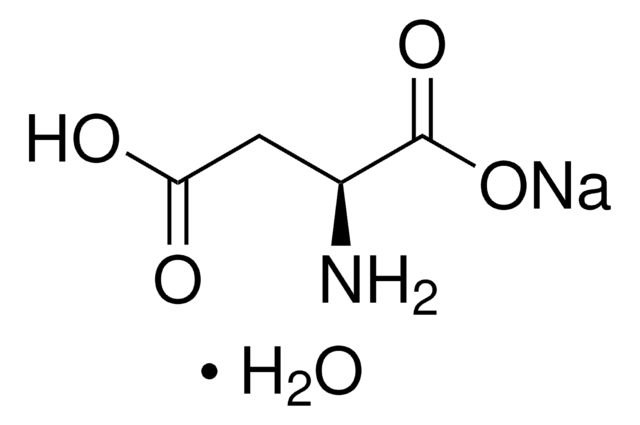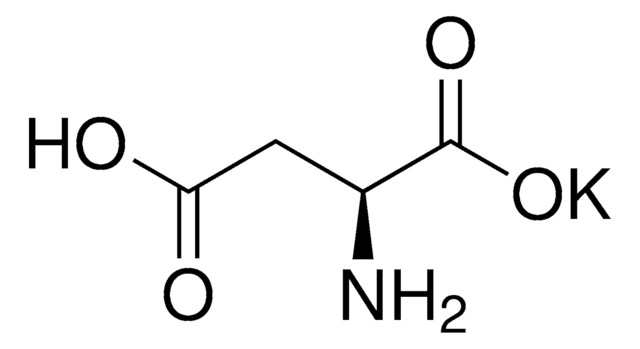Wichtige Dokumente
A8949
L-Asparaginsäure
≥99% (HPLC), BioXtra
Synonym(e):
(S)-2-Amino-bernsteinsäure, (S)-2-Aminobutandisäure
About This Item
Empfohlene Produkte
Produktbezeichnung
L-Asparaginsäure, BioXtra, ≥99% (HPLC)
Produktlinie
BioXtra
Assay
≥99% (HPLC)
Form
powder
Verunreinigungen
≤0.0005% Phosphorus (P)
≤0.1% Insoluble matter
Glührückstand
≤0.1%
Farbe
white to off-white
mp (Schmelzpunkt)
>300 °C (dec.) (lit.)
Löslichkeit
1 M HCl: 0.5 M, clear, colorless
Anionenspuren
chloride (Cl-): ≤0.05%
sulfate (SO42-): ≤0.05%
Kationenspuren
Al: ≤0.0005%
Ca: ≤0.001%
Cu: ≤0.0005%
Fe: ≤0.0005%
K: ≤0.005%
Mg: ≤0.0005%
NH4+: ≤0.05%
Na: ≤0.005%
Pb: ≤0.001%
Zn: ≤0.0005%
SMILES String
N[C@@H](CC(O)=O)C(O)=O
InChI
1S/C4H7NO4/c5-2(4(8)9)1-3(6)7/h2H,1,5H2,(H,6,7)(H,8,9)/t2-/m0/s1
InChIKey
CKLJMWTZIZZHCS-REOHCLBHSA-N
Angaben zum Gen
human ... CA1(759) , CA2(760)
rat ... Grin2a(24409)
Suchen Sie nach ähnlichen Produkten? Aufrufen Leitfaden zum Produktvergleich
Anwendung
- Metabolomics Analysis Identifies Differential Metabolites as Biomarkers for Acute Myocardial Infarction.: Research identifies key metabolites, including L-Aspartic acid, involved in the metabolic pathways affected during acute myocardial infarction. This study enhances the understanding of biochemical changes during heart attacks, potentially leading to better diagnostic markers (Zhou et al., 2024).
Biochem./physiol. Wirkung
Lagerklassenschlüssel
11 - Combustible Solids
WGK
WGK 1
Flammpunkt (°F)
Not applicable
Flammpunkt (°C)
Not applicable
Persönliche Schutzausrüstung
dust mask type N95 (US), Eyeshields, Gloves
Hier finden Sie alle aktuellen Versionen:
Besitzen Sie dieses Produkt bereits?
In der Dokumentenbibliothek finden Sie die Dokumentation zu den Produkten, die Sie kürzlich erworben haben.
Kunden haben sich ebenfalls angesehen
Chromatograms
application for HPLCapplication for HPLCUnser Team von Wissenschaftlern verfügt über Erfahrung in allen Forschungsbereichen einschließlich Life Science, Materialwissenschaften, chemischer Synthese, Chromatographie, Analytik und vielen mehr..
Setzen Sie sich mit dem technischen Dienst in Verbindung.





